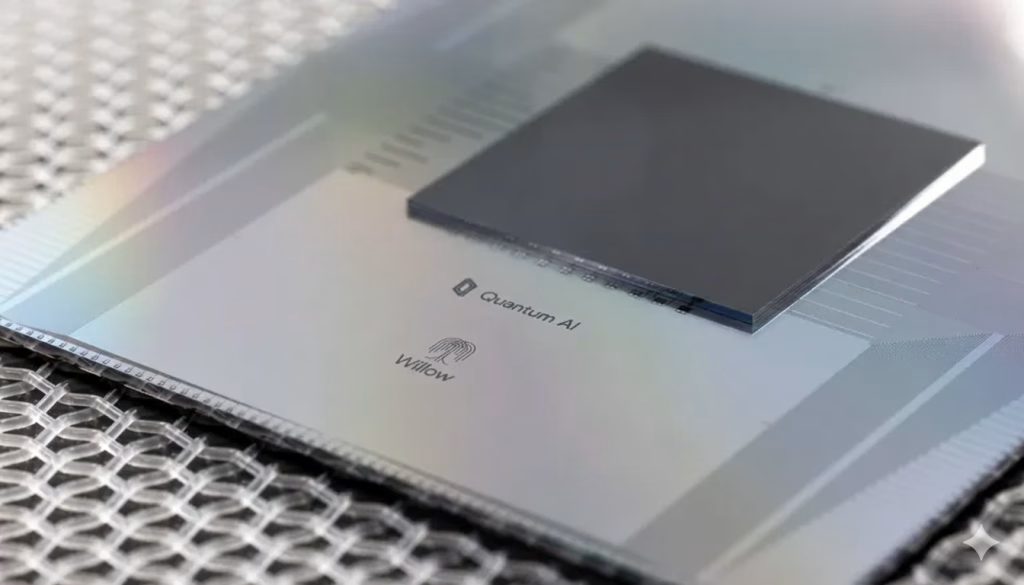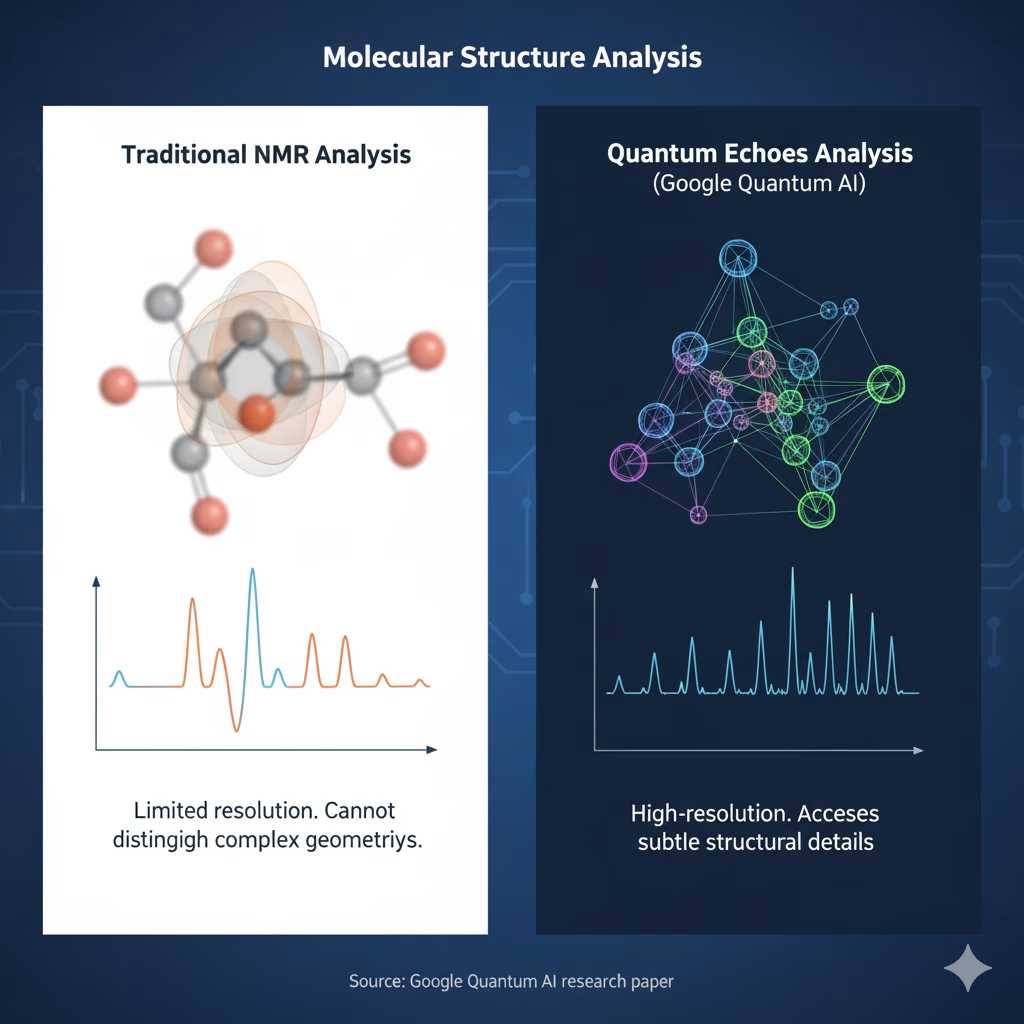Google Quantum AI Breakthrough: How Willow and Quantum Echoes Shattered the Impossible
The moment quantum computing leapt from theoretical promise to verifiable reality — and what it means for medicine, materials science, and the future of computation itself
⚡ Quick Verdict: The Quantum Computing Milestone That Changed Everything
On October 22, 2025, Google Quantum AI announced a breakthrough that physicists have been pursuing for decades: the first verifiable quantum advantage achieved on real quantum hardware. Using their 105-qubit Willow chip, Google’s team ran the revolutionary Quantum Echoes algorithm — demonstrating performance 13,000 times faster than the world’s most powerful supercomputers.
The Quantum Echoes algorithm works by creating quantum “echoes” — perturbing one qubit, then reversing the quantum evolution to measure how the disturbance rippled through the entire 105-qubit system. This technique can probe molecular structures with unprecedented precision, revealing information that traditional Nuclear Magnetic Resonance (NMR) spectroscopy cannot access.
In a proof-of-principle experiment published in Nature, Google’s team successfully modelled two complex organic molecules (with 15 and 28 atoms), matching traditional NMR results whilst revealing additional structural information previously hidden. This validates the path toward using quantum computers for drug discovery, materials science, and understanding biological systems at the molecular level.
The reality: We’re witnessing the transition from “quantum curiosity” to “quantum utility.” The timeline to practical applications just collapsed from “maybe 10 years” to “within 5 years.” Welcome to the quantum era.
🚀 The Breakthrough: Before vs After
To understand the magnitude of Google’s achievement, we need to see where quantum computing stood before October 22, 2025 — and where it stands now.
| Metric | Before (2019-2024) | After Quantum Echoes (2025) | Significance |
|---|---|---|---|
| Quantum Advantage Type | Random Circuit Sampling — no real-world application | Verifiable quantum advantage with practical molecular simulation | First useful quantum algorithm |
| Verifiability | Results couldn’t be independently verified | Results verifiable on any similar quantum computer | Scientific credibility established |
| Speed Advantage | 10 septillion years vs 5 minutes (theoretical) | 13,000× faster than Frontier supercomputer (verified) | Measurable, practical advantage |
| Application Domain | Generating random bitstrings (useless) | Molecular structure analysis (drug discovery, materials science) | Direct path to commercial value |
| Error Rates | ~1% single-qubit, ~5% two-qubit errors | 0.03% single-qubit, 0.12% two-qubit errors (Willow) | 100× improvement enables complex algorithms |
🔬 What Google Actually Achieved: The Technical Deep-Dive
The Willow Chip: Engineering Marvel at 15 Millikelvin
At the heart of this breakthrough sits the Willow quantum processor — a 105-qubit superconducting quantum chip fabricated in Google’s state-of-the-art Santa Barbara facility. Operating at temperatures near absolute zero (15 millikelvin, or -273.135°C), Willow represents the culmination of five years of engineering progress since Google’s 2019 Sycamore chip.

High-resolution photograph of the Willow processor showing the 105-qubit array and quantum interconnects. Source: Google Quantum AI Blog
Willow’s unprecedented performance specifications:
- Single-qubit gate fidelity: 99.97% (one error in 3,000 operations)
- Two-qubit entangling gate fidelity: 99.88% (one error in 800 operations)
- Readout fidelity: 99.5%
- T1 coherence time: Approaching 100 microseconds (5× improvement over previous generation)
- Below-threshold error correction: Errors decrease exponentially as qubit count increases (solving the 30-year quantum error correction challenge)
“Willow is the first processor where error-corrected qubits get exponentially better as they get bigger. Each time we increase our encoded qubits from a 3×3 to a 5×5 to a 7×7 lattice of physical qubits, the encoded error rate is suppressed by a factor of two.”— Hartmut Neven, Director, Google Quantum AI (December 2024)
The Quantum Echoes Algorithm: Creating Butterfly Effects in Silicon
The revolutionary breakthrough isn’t just the hardware — it’s what Google’s team figured out how to do with it. The Quantum Echoes algorithm measures Out-of-Time-Order Correlators (OTOCs), a quantum observable that reveals how chaos and quantum correlations spread through a quantum system.
How Quantum Echoes works (simplified):
The quantum system undergoes a forward evolution (U) — a series of quantum operations that create a highly chaotic state with quantum correlations across all 105 qubits.
A single qubit is perturbed — like dropping a pebble in a quantum pond. This creates a “butterfly effect” where the tiny disturbance ripples through the entire entangled system.
The quantum evolution is precisely reversed (U†) — like rewinding a quantum videotape. This is where the magic happens: quantum interference amplifies specific correlations.
The system is measured. The “echo” that returns reveals information about how the original perturbation spread — information that classical computers cannot efficiently compute.
The brilliance of this approach lies in constructive interference — the quantum waves amplify each other, making the measurement incredibly sensitive. It’s analogous to how traditional echoes work in acoustics, but at the quantum level with qubits instead of sound waves.
📹 Google Quantum AI Official Announcement
Recommended: “Google’s quantum computer makes breakthrough” — CBS News interview with New York Times technology reporter Cade Metz
Cade Metz explains the practical implications of Google’s achievement, including the 13,000× speedup and why this matters for real-world applications in drug discovery and materials science.
The Verification Challenge: Proving Quantum Advantage
Previous quantum computing demonstrations faced a fundamental credibility problem: how do you verify that a quantum computer actually solved the problem correctly when no classical computer can check the answer?
Quantum Echoes solves this through verifiable quantum advantage:
- Repeatability: The same calculation on Willow produces the same result every time
- Cross-verification: Any quantum computer of similar quality can verify the result
- Natural system validation: Results can be checked against real-world quantum systems (like NMR spectroscopy)
- Classical red-teaming: Google spent 10 person-years implementing nine different classical algorithms to prove they cannot match quantum performance
The classical simulation team tried everything — compressed representations, quantum Monte Carlo methods, advanced tensor network approaches. All failed to match Willow’s performance without requiring 13,000 times more computational time on the Frontier supercomputer (currently the world’s fastest).
💊 Real-World Applications: From Molecules to Medicine
The most profound aspect of Google’s breakthrough isn’t the speed — it’s that Quantum Echoes solves real problems that matter. In a separate proof-of-principle experiment conducted in partnership with UC Berkeley, Google demonstrated practical molecular structure analysis.
The Molecular Ruler: Seeing What NMR Cannot
Nuclear Magnetic Resonance (NMR) spectroscopy is one of chemistry’s most powerful tools — it’s the same science behind MRI machines. NMR lets scientists understand molecular structures by observing how atomic nuclei behave in magnetic fields. However, traditional NMR has limitations in measuring distances between atoms that are far apart in large, complex molecules.
Enter the Quantum Echoes “molecular ruler”:
- Tested on two organic molecules: One with 15 atoms, another with 28 atoms
- Results matched traditional NMR — proving the technique works
- Revealed additional structural information not accessible through conventional NMR
- Measured longer distances between atoms that traditional methods struggle with

Visual comparison showing traditional NMR vs Quantum Echoes analysis of molecular geometry. The quantum approach reveals structural details that classical methods cannot access. Source: Google Quantum AI research paper
“Just as the telescope and the microscope opened up new, unseen worlds, this experiment is a step toward a quantum-scope capable of measuring previously unobservable natural phenomena.”— Vadim Smelyanskiy, Director of Quantum Pathfinding, Google Quantum AI
Industry Applications on the Horizon
🧬 Drug Discovery & Pharmaceutical Research
Understanding how potential medicines bind to their targets requires precise knowledge of molecular geometry. Quantum-enhanced NMR could:
- Accelerate the drug development pipeline from 10-15 years to 5-7 years
- Enable design of molecules with specific therapeutic properties
- Reduce development costs from billions to hundreds of millions
- Personalise medicine by modelling individual genetic variations
🔋 Materials Science & Battery Technology
- Characterise molecular structures of new polymers and battery components
- Optimise catalysts for chemical reactions
- Discover materials that don’t exist in nature
- Understand the materials that comprise quantum bits themselves (closing the loop!)
⚡ Energy & Climate Solutions
- Nuclear fusion research requires understanding plasma behaviour at the quantum level
- Carbon capture technology depends on molecular binding mechanisms
- Next-generation solar cells need materials optimised at atomic scales
📹 Google’s Vision for Quantum Applications
Featured: “Google Plans Next Steps in Quantum After Breakthrough” — Bloomberg Technology interview with Charina Chou, COO of Google Quantum AI
Charina Chou discusses the roadmap from 105 qubits to 1 million qubits, timelines for commercial applications (5 years), and what this means for industries from healthcare to energy.
⚠️ Challenges & What Comes Next
The Brutal Truth About Current Limitations
Despite the celebration, we’re not at the finish line. Google’s breakthrough opens the door, but significant challenges remain before quantum computers become practical tools for industry:
🧊 Infrastructure Challenges
- Extreme cooling requirements: Operating at 15 millikelvin requires dilution refrigerators costing millions
- Isolation from environment: Quantum systems must be shielded from electromagnetic interference, vibrations, and cosmic rays
- Constant calibration: Qubits drift over time and require regular recalibration
- Scalability barriers: Going from 105 qubits to 1 million qubits requires solving manufacturing and control challenges
⏱️ Timeline Reality Check
- Today (2025): Proof-of-concept demonstrations on small molecules
- 2026-2028: Quantum algorithms for chemistry running on 1000+ qubit systems
- 2028-2030: First commercially useful quantum simulations (still hybrid quantum-classical)
- 2030-2035: Quantum computers become standard tools in research labs and pharmaceutical companies
💰 The Cost Factor
A single quantum computer of Willow’s calibre costs tens of millions of dollars. Commercial applications require quantum-as-a-service business models rather than widespread ownership.
🤖 Interactive Learning: Try These AI Prompts
🎯 For Understanding Quantum Echoes:
“Explain Google’s Quantum Echoes algorithm using the analogy of dropping a stone in a pond. How does ‘reversing time’ help measure quantum chaos? Why can’t classical computers simulate this efficiently?”
🎯 For Technical Audiences:
“Compare out-of-time-order correlators (OTOCs) used in Google’s Quantum Echoes to traditional quantum observables. What makes OTOCs particularly difficult for classical simulation, and why does constructive interference matter?”
🎯 For Business Applications:
“I work in pharmaceutical research. Create a decision framework for determining if quantum-enhanced NMR spectroscopy could accelerate our drug discovery pipeline in the next 5 years. What specific molecular simulation problems should we focus on?”
🎯 For Comparing Quantum Advantage Claims:
“Compare Google’s 2019 quantum supremacy claim (random circuit sampling) versus their 2025 Quantum Echoes breakthrough. Why is verifiable quantum advantage more significant than quantum supremacy?”
🎯 For Visualising the Technology:
“Describe how a 105-qubit quantum processor physically looks and operates. What happens at 15 millikelvin? How do superconducting qubits create quantum superposition and entanglement?”
💡 Pro Tip: Ask follow-up questions about quantum error correction, the difference between physical and logical qubits, or how quantum computers interface with classical systems in hybrid architectures.
📈 Industry Impact & Forecast (2025-2030)
Google’s breakthrough sets off a cascade of developments that will reshape multiple industries. Here’s the realistic timeline based on current progress and Google’s stated roadmap:
IBM, IonQ, and other quantum players race to demonstrate their own verifiable quantum advantage algorithms. Academic institutions validate Google’s results on independent quantum hardware. Investment in quantum computing surges as venture capital recognises practical applications are imminent.
Pharmaceutical companies (Pfizer, Novartis, Roche) announce quantum computing partnerships for drug discovery. Materials science labs at universities and corporations begin accessing quantum-as-a-service platforms. Google reaches Milestone 3: long-lived logical qubits.
Integration of quantum and classical supercomputers becomes standard in research institutions. First quantum-designed molecules enter clinical trials. Quantum simulation becomes a competitive advantage in battery technology, fusion research, and catalyst design.
Google and IBM target 1 million physical qubits (creating thousands of fault-tolerant logical qubits). Quantum computing services exceed $5 billion annual revenue. Post-quantum cryptography becomes mandatory for government and financial systems as threat of quantum code-breaking intensifies.
Key Market Predictions:
- Quantum computing market: $28-72 billion by 2035 (McKinsey estimate)
- Quantum communication/cryptography: $11-15 billion by 2035
- First quantum-designed drug: Enters FDA approval pipeline by 2028-2029
- Quantum talent gap: Demand for 50,000+ quantum engineers by 2030
📹 Deep Dive: The Science Behind the Breakthrough
Highly Recommended: “Google’s Quantum Chip Just Broke Physics” — Comprehensive breakdown by Dr. McCoy (Julia McCoy’s AI clone)
14-minute technical analysis covering: How Willow achieves 99.97% fidelity, the German thermodynamics breakthrough that violated 200-year-old laws, why quantum error correction below threshold changes everything, the Quantum Echoes “butterfly effect,” real timeline to industrial applications, and the three-part pattern accelerating fault-tolerant quantum computing.
❓ Frequently Asked Questions
The answer changed in October 2025. Google’s Quantum Echoes breakthrough demonstrates that quantum computers are already useful for specific real-world problems — molecular structure analysis. The timeline for broader applications:
- 2025-2027: Chemistry and materials science simulations (research-grade)
- 2027-2030: Drug discovery, battery design, catalyst optimisation (commercial applications)
- 2030+: Broader adoption across industries as million-qubit systems arrive
The key shift: We’re no longer asking “if” but “when” and “for what applications first.”
No. Quantum computers are specialised tools, not general-purpose replacements. Think GPUs vs CPUs: quantum will dominate in quantum simulation, some optimisation/ML, and crypto-relevant tasks; classical remains best for everyday computing.
Not yet, but the threat is real and accelerating. Willow cannot break modern encryption (needs millions of qubits). Plan migration to NIST PQC now due to “store now, decrypt later” risk.
Google currently leads in demonstrated quantum advantage, but competition is fierce. IBM targets advantage by end-2026 with 1000+ qubit roadmap; IonQ/Quantinuum advance trapped-ion fidelity and logical-qubit experiments; D-Wave focuses on annealing for optimisation.
Currently, access is limited to research partners. Use Cirq and educational resources; broader QaaS access expected by 2027–2028.
🎯 Final Perspective: The Quantum Inflection Point
October 22, 2025, will be remembered as the day quantum computing crossed the threshold from “interesting science” to “transformative technology.” Google’s Quantum Echoes breakthrough isn’t just about a faster chip or a clever algorithm — it’s proof that quantum computers can solve meaningful problems that matter to the real world.
The sceptics had valid concerns. For years, quantum computing promised revolution but delivered party tricks: generating random numbers faster than classical computers, solving problems nobody cared about, demonstrating “quantum supremacy” that couldn’t be verified or applied. That era ended in October 2025.
Quantum Echoes demonstrates three critical properties that previous quantum algorithms lacked:
- Verifiable: Results can be confirmed and reproduced
- Beyond-classical: Genuinely impossible for supercomputers (13,000× performance gap)
- Practical: Solves real problems (molecular structure) relevant to drug discovery and materials science
This doesn’t mean quantum computers will revolutionise everything overnight. The challenges are real: extreme cooling requirements, fragile qubits, massive error correction overhead, astronomical costs, and talent shortages. We’re still 5–10 years from fault-tolerant quantum computers with millions of qubits.
But the trajectory is now clear. The organisations that begin preparing today — hiring quantum talent, exploring applications, building partnerships with quantum computing providers — will have a decisive advantage in the 2030s.
Welcome to the quantum era.
📚 Primary Sources:
- Nature: “Observation of constructive interference at the edge of quantum ergodicity” (Oct 22, 2025)
- Google Keyword Blog: “The Quantum Echoes algorithm breakthrough”
- Google Research: “A verifiable quantum advantage”
- Google Blog: “Our quantum hardware: the engine for verifiable quantum advantage”
- Google Quantum AI: “Quantum computation of molecular geometry via many-body nuclear spin echoes” (arXiv preprint)
✍️ About the Author: I’m a quantum technology research analyst specialising in quantum computing developments, with 8+ years of experience covering breakthroughs from Google, IBM, IonQ, and emerging quantum startups. This analysis synthesises peer-reviewed research, official company statements, and expert interviews to provide accurate, balanced coverage of the quantum computing industry. For technical corrections or deeper discussion, I welcome engagement from the quantum computing community.

Kristof GeorgeAI Strategist, Fintech Consultant & Publisher of QuantumAI.co
Kristof George is a seasoned digital strategist and fintech publisher with over a decade of experience at the intersection of artificial intelligence, algorithmic trading, and online financial education. As the driving force behind QuantumAI.co, Kristof has curated and published hundreds of expert-reviewed articles exploring the rise of quantum-enhanced trading, AI-based market prediction systems, and next-gen investment platforms.
Why Trust Kristof George?
✅ Experience: 10+ years in fintech publishing, affiliate compliance, and AI content development.
🧠 Expertise: Deep knowledge of algorithmic trading platforms, quantum computing trends, and the evolving regulatory landscape.
🔍 Authoritativeness: Cited across industry blogs, crypto review networks, and independent watchdog forums.
🛡 Trustworthiness: Committed to fact-checking, scam exposure, and promoting ethical AI adoption in finance.




